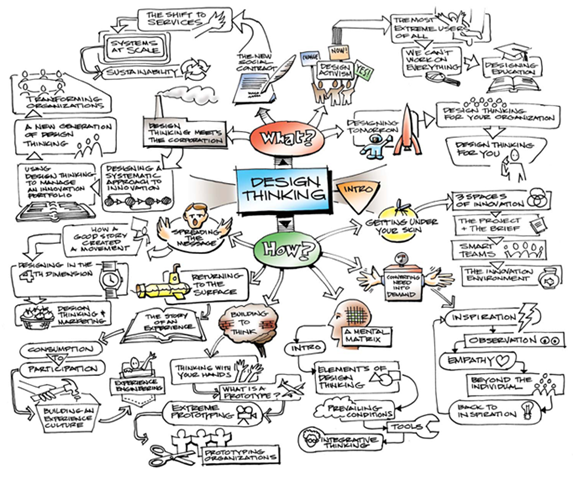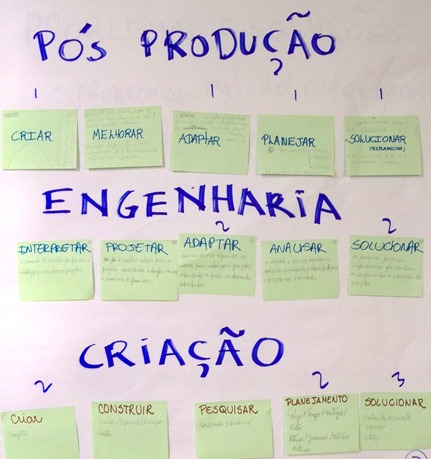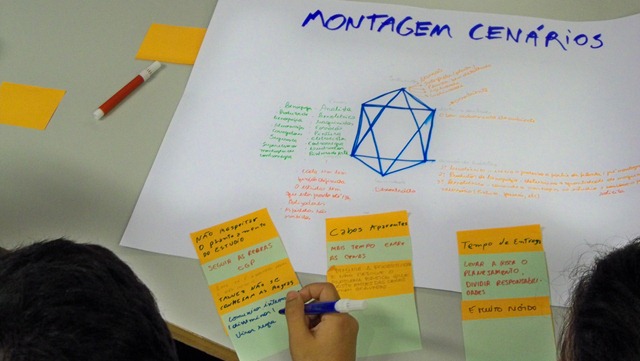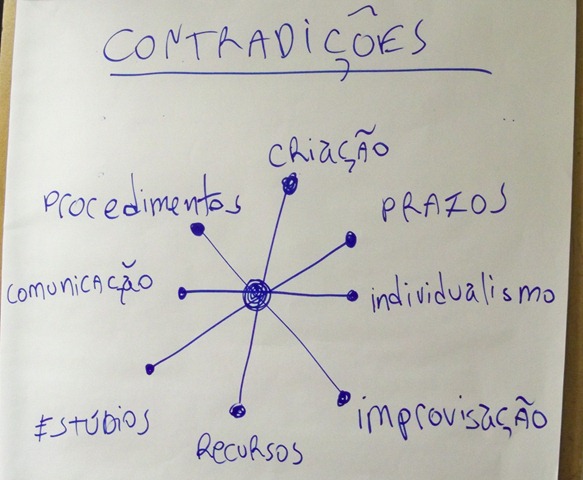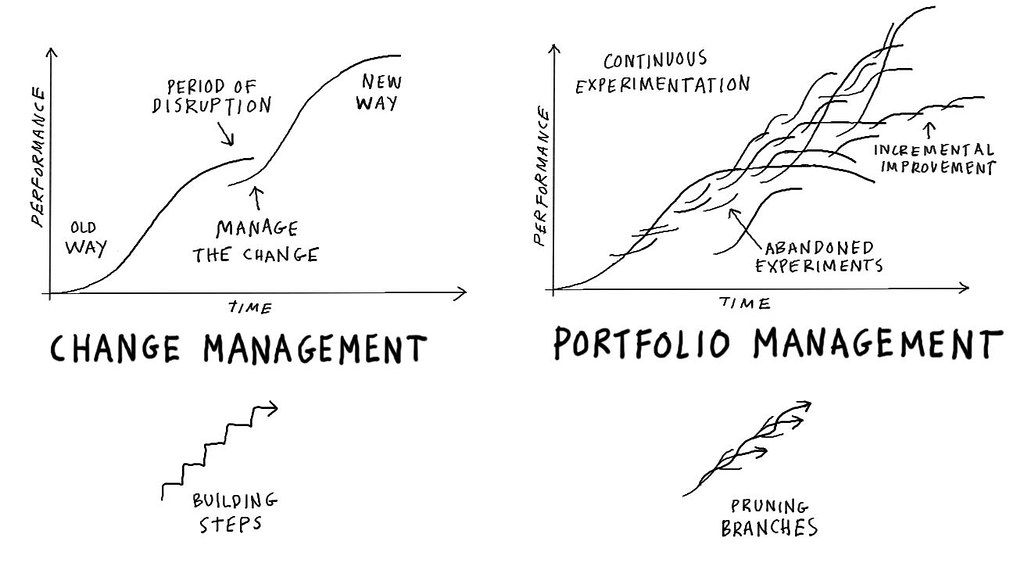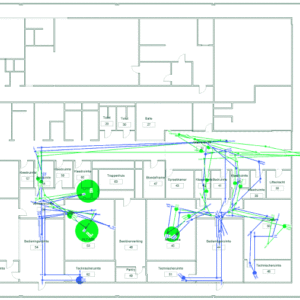During my last trip to Brazil, together with Andre Malheiro, I conducted a Design Thinking workshop at Rede Globo, the producer of the famous Brazilian soap operas. I’ve been experimenting using Activity Theory as a framework for Design Thinking in these kind of workshops for a while, but after this, I got an important insight: Design Thinking should be cultivated from the situated knowledge people already have about their work.
Design Thinking is usually presented as a set of general practices that could be useful to areas other than Design itself. Design practices are imported and adapted to current process, without considering much the situated design knowledge the organization already have.
The mind map that Tim Brown made for the book Change by Design makes it clear:
Visualizing what they know
At Faber-Ludens we believe that not everyone is a designer, but everyone do design eventually. Our Design Thinking approach is to let people be conscious about design knowledge they already have and collaborate with others who might have a different design knowledge.
With this in mind, our students have developed a nice method for kicking off Design Thinking workshops.
- People are separate into groups according to their departments
- They choose 5 among a set of 30 verbs that are commonly associated to design like ‘planning’, ‘solving’, ‘improving’, ‘innovating’, ‘analyzing’
- Each chosen verb is written down in a post-it, followed by descriptions of the last situation the team used the verb
- Post-its are arranged in a shared display and a discussion follows on similiarities and differences regarding Design Thinking between the departments
This is what we got from Rede Globo post-production, engineering and creative departments. The most common verb was ‘solving’ (solucionar).
Mapping activities
After the discussion, we asked them to map the activities that connected the departments. More often than not, conflicts arise in these connections and we wanted to discuss them. According to Activity Theory, conflicts are sources of innovation, so we wanted to heat things up.
Participants used Engeström Activity System as a template for mapping two connected activities: scenario set-up and studio engineering.
We didn’t asked them to look for contradictions at first, because that’s a difficult concept to understand. Contradictions are not simple problems that can be solved by technical solutions. Contradictions are historically accumulated tensions between social relationships, characterized by opposite forces that cannot be simply removed. The struggle between these opposite forces is what makes activity systems evolves, so they are neither good nor bad for activities.
The activity system was employed to situate them onto existing process and elicit their knowledge about them.
Problematizing
If we asked them to look for contradictions in the activity system, they would find problems instead, which is not the same concept. A problem, in a design sense, is the identification of a shortcoming in a situation that can be overcome by changing one objective aspect of that situation, usually by introducing a new technology. The change is often called a solution.
It’s not strange that solving was the single word that all three departments chose during previous exercise, but none mentioned problematizing. I asked workshop participants why they didn’t chose problematizing and they answered that problems were external to their work, either coming from the objective reality — like a machine breakdown — or from other departments, like a design task. In short, they didn’t pay effort on thinking about problems.
We wanted them to deliberately think about problems because when accepting the problem as a given, the possible solutions are very limited. There is little innovation possible when problems are well defined.
We proposed the PSP game, another method developed by our students, to elicit problems and solutions at the connections between the two mapped activities. The method asks for problems (orange Post-Its), then solutions (green Post-its), then problems of the solutions (orange), and so on.
Our game’s goal was not to generate feasible solutions, which would require way more work. Our goal was to stimulate participants to reflect on the importance of problematization.
Paulo Freire, the famous Brazilian educator who taught illiterate adults, emphasized problematization to break out recurring social conflicts. Instead of giving them problems to solve, he helped students to create their own problems by asking questions about their underlying assumptions on a subject matter. He wanted to make them perceive hidden contradictions in everyday situations and develop tactics to deal with them in a pro-active way. The contradictions his students found were usually related to their social status, being disrespected or underestimated, for instance. They could not solve these social issues, but they could learn how to deal with that.
Living with contradictions
From the game, we got some threads of recursive problems and solutions, like this:
- Problem: studio setup time takes longer than expected
- Solution: enforce the plan
- Problem: too rigid
- Solution: increase timescale for studio setup
- Problem: recording would have not enough time
- Solution: increase studios space area
As we can see, none of above solutions are final. No imported best practices would give them final solutions, because they are tied to the limits of the situation. Donald Schön observed that designers, instead of developing their solutions by isolated insights, they engage into a conversation with the situation, trying different arrangements before deciding the best fit. When dealing with not yet reified social relationships, however, designers find it difficult to grasp the boundaries of the situation.
When discussing the problems and solutions they generated, Rede Globo employees realized that they don’t have clear work process but everything works like a charm because everyone knows what to do. Every worker has a very specialized task and no one dares to assume other’s responsibility. At the other hand, they improvise a lot in their own domain.
This was the first contradiction they found, which should not be “solved” because it’s both weakness and strength of the team. After that, other contradictions popped up from the situation, in a ripple effect. We’ve constructed along the discussion a star diagram. The contradictions found were between creating and resources, available studios and schedules, procedures and improvisation, and between individualism and communication.
Zone of Proximal Development
Vygotski observed that interaction with a a more capable adult helped children on solving problems. Adult interaction expanded the range of possible things to learn by connecting what the child know to what he/she could learn. He called that range of possibilities Zone of Proximal Development. Often, artifacts are used to mediate these interactions, like the abacus. The artifact is internalized until the child doesn’t need it anymore. He can count on his own, using an internal artifact he built for himself, the counting skill.
Inside an organization of adults, there is hardly anyone that could be considered as “more capable”. But, every adult has a different notion that could be shared and learnt by interacting with peers. Interacting with the single purpose of sharing knowledge doesn’t work for everyone because not everyone can grasp the motive of such an activity. So, how can we expand the Zone of Proximal Development of an organization?
I believe Design Thinking has a very nice contribution to that: organizing people around projects. Projects creates the appropriate context for focused knowledge sharing, a temporary power structure that is more horizontal, facilitating peer collaboration. The organization can test new ways of organizing people, new tools for working, new business models.
By the end of the workshop, we advised Rede Globo on two things:
- Capture design knowledge that are dispersed across the organization and systematize into practical tools that can be used during actual work practices
- Create a lab for pilot projects that test tools before disseminating across the whole organization
Instead of devising a strategic plan for changing the organization culture to a Design Thinking mindset, Faber-Ludens helps organization to move from change management to portfolio management, as Dave Gray cleverly expressed in his diagrams.
The need for situated Design Thinking
There are many Design Thinking consultancy going around without any theoretical foundations. I presented here one possible framework: Activity Theory. If you look at academic studies on Design Thinking, you can find many accounts on individual designer practice, discussion of abstract design process, cognitive models, and other topics that doesn’t help practitioners on facing the organizational change they need to make happen. Activity Theory is collective, systemic, and it has an old tradition of looking at organizational change.
I believe there is a great opportunity for situated accounts of Design Thinking. If you know anything like that with another framework, please drop me a comment bellow.
